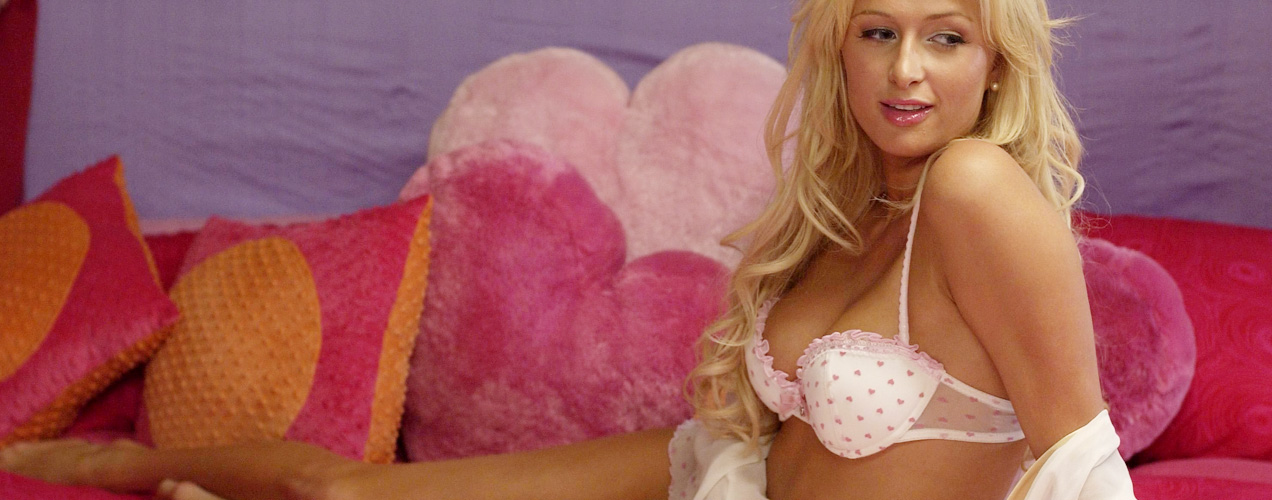2008 / Tom Putnam > Last year, I was slotted a silly, amateurishly made yet almost jovial little sci-fi horror flick called Raptor for Lucid Screening’s White Elephant Film Blogathon. Because the film didn’t take itself so seriously, I was inclined to comment on it in a satirical fashion, tongue-in-cheek with lots of superlatives and naked praise. This year, I expected to do more of the same, but to my great surprise, Tom Putnam’s The Hottie and the Nottie is not a joke. This is a mostly serious production with mostly serious intents. But as it sits at #51 on the IMDb Bottom 100 (up from #1), one has to wonder where it all went wrong.
Let’s start at square one: Director Putnam’s last film was Red White Black & Blue, a respectable PBS documentary about the Japanese invasion of Alaska in 1942. It stands in out in history as being the first and only time since the War of 1812 that a foreign country has invaded American soil. Everyone from trade bible Variety to The Christian Science Monitor and The Boston Globe laid accolades on it, the latter calling it “a wrenching look at a forgotten battle.” So how does the director of that go forth in directing this, a movie that was pimped out to the masses in the guise of a Paris Hilton showcase? The truth is, I don’t know. I don’t know Putnam, but one thing is for sure: Hollywood isn’t easy, and every critic and commentator out there blindly splashing manure at this piece of work because of Hilton’s involvement ought to be ashamed of themselves for not being more considerate.
The Hottie and the Nottie is not a classic. It’s not even good enough to become a cult favorite. It’s mediocre at best, though it should be filed a couple of notches below that. But it’s also not as bad as the reviews would suggest. My disgust stems from incendiary commentaries around the Internet that knock this movie down simply because of Hilton’s involvement. There are proper ways to be critical and then there are half-assed ways. Much of what I’ve read is of the mooning assortment, devoid of respect for the hard work of all the individuals who actually did hone their craft on this unfortunate movie. Show your anger at those who caused this to be such a disaster. First of all, the marketing is terrible. The posters and DVD covers have Hilton (“the Hottie”) glowing in a white bikini while pal Christine Lakin (“the Nottie”) stands behind her looking like the offspring of The Goonies’ Sloth and the mother from Peter Jackson’s Braindead. It’s an unappealing sight undoubtedly Photoshopped for further effect, and simply a bad business decision. If there’s really anyone who could be blamed for the failure of such a production, it would have to be the marketers and whoever was responsible for the casting of Paris Hilton.
The writing is good enough for what the movie was supposed to be: A run-of-the-mill My Fair Lady with a slight twist. But Hilton cannot act. She’s statuesque, almost frigid and incapable of evoking emotion. She’s not even the lead, yet she ruins every scene she’s in. One could argue that her celebrity has caused us to take her less seriously, but then how do you respond to the way Angelina Jolie marveled in A Mighty Heart? Good and great actors work beyond their real-life egos to make audiences believe, but Hilton, flush with her family fortune, lacks that in spades. In fact, what may be scary is that her performance in this was only slightly worse than in 1 Night in Paris. Recast her character and we’ve already improved the final product by 100%.
Story-wise, the fundamental problem with makeover movies is that they’re predictable. You know the protagonist will get the once-ugly girl. That’s the formula, but give credit to screenwriter Heidi Ferrer for trying to change things up a little. Lakin (who most of us remember from the mid-90s TGIF sitcom Step by Step alongside Patrick Duffy and Suzanne Sommers) transforms in a more respectable fashion than usual in this sub-genre. It’s natural and readily believable. And while Lakin isn’t Rachel Leigh Cook, she’s still a formidable ugly duckling. Even Joel David Moore, known primarily for the portrayal of a wacky game designer in Grandma’s Boy, puts forth the kind of lovable loser performance that’s bound to tug a couple of heart strings.
So, about Putnam and Hilton and the film as a whole: How did this occur? Hilton is listed as executive producer, so maybe her Benjamins influenced the direction. Maybe Putnam realized making documentaries wasn’t the way to pay rent. Maybe the marketers saw the final product, realized it stunk of six-month old milk and decided to sell it to the VH1, I Love New York niche-market that loves celeb trash to death. But even they’ll be disappointed. Either Putnam or Hilton or someone else with muscles flexed them to the point where the film’s identity crisis forcibly looms over its path to success: Too serious to be taken as a gross-out romantic comedy, and too ridiculous to be satirized.

